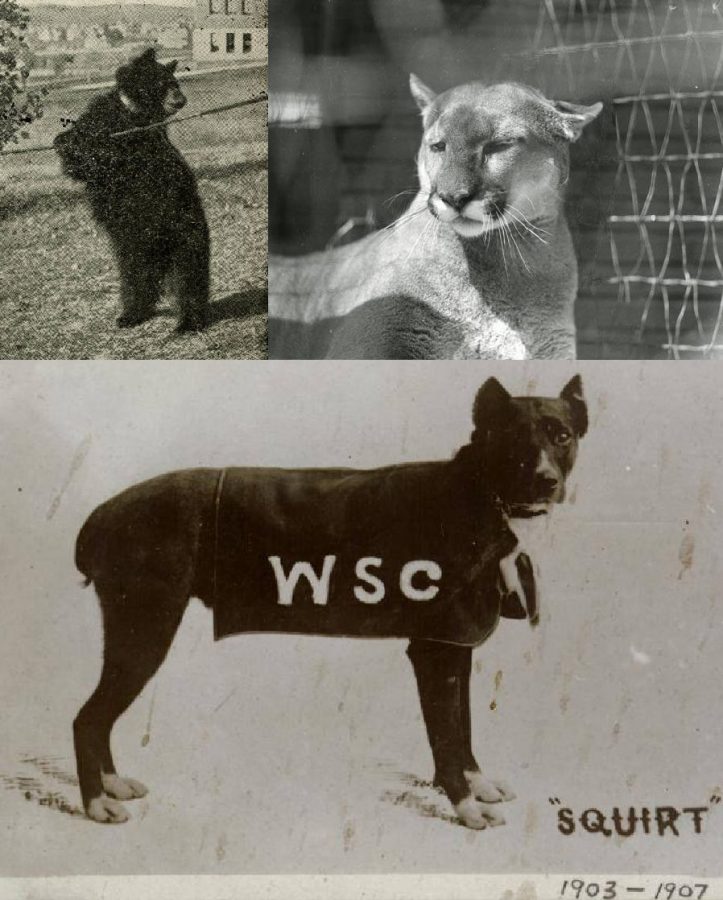Puma concolor: our mighty mascot
It’s time for a cougar crash course; let’s see how much you really know about our mascot
Top Left: Toodles, 1906 (Courtesy of MASC, WSU Libraries) Top Right: Butch I, 1932 (Courtesy of Hutchison Collection, MASC, WSU Libraries) Bottom: Squirt, 1906 (Courtesy of MASC, WSU Libraries)
August 19, 2021
Cougars are common around campus, whether it’s the Cougar logo on street signs or Butch T. Cougar at sports events. However, we weren’t always the Cougars.
Perky pup Squirt is believed to have been the WSU’s first mascot, arriving in 1904. Other live mascots during the early 1900s included a stocky dog named Bull, feisty pup Billie and several other small dogs. Yes, you heard me right — first mascots were dogs. Thankfully, we’ve changed our ways since then and left the dogs for the dawgs.
Along with our school pups, an additional mascot was added to the records in 1905. When Squirt was stolen in Corvallis, Oregon, during an away football game, our football team wasn’t going to just sit around. They decided to do something about it: steal the Oregon team’s mascot, of course! So, Toodles the black bear was bear-napped back to WSU. Oregon let the scandal slide, and WSU students liked him so much he became a part of the mascot team.
Cougars don’t enter the story until 1919. A report commenting on our football team’s victory against a California team stated with pride that we “played like cougars!” Needless to say, students embraced the moniker and designated themselves the Cougars. A month later, the governor of Washington gifted the college a live cougar mascot, naming him after impressive Cougar quarterback Herbert “Butch” Meeker.
Thus, the Cougar era began! And so it continues today. But why were students so fond of this creature, choosing it over the previously favored mascots? It all comes down to the amazing abilities these cats possess. It’s time for a Cougar Crash Course: let’s see how much you really know about our mascot!
Puma concolor, the cougar, is the most widespread terrestrial mammal in the Western Hemisphere. Thanks to a load of adaptations — insulating fur, strong forelimbs and jaws and a flexible diet — cougars can live nearly anywhere, from Peru’s arid, scrubby plains to the highest reaches of the chilly Canadian Rockies.
Since they are an apex predator, cougars require large swaths of land to satisfy their appetites: a single cat’s territory may cover almost 400 square miles. Some cougars inhabit the same areas year-round, while others have seasonal ranges, migrating in fall and spring to follow prey (much like WSU students traveling home for the summer and returning to campus in the fall).
They are cunning predators, and although solitary, their hunting success rates place above those of even the most skilled wolf packs. Cougars can take down a bull moose over seven times their size! However, they prefer smaller ungulates like deer and elk, and some cougars specialize in other prey like coyotes and porcupines.
Their powerful hind legs provide the burst of speed required for their characteristic ambush attacks, while their large front paws are the key to catching fleeing prey. And that long, fluffy tail? It acts as a rudder, balancing the cat as it runs and pounces.
Cougars are impressive athletes when it comes to both climbing and jumping; they often seek refuge in towering pines and firs and can spring more than 18 vertical feet from a static crouch! One last misconception to clear up: cougars aren’t considered “big cats” because they can’t roar. Instead, similar to house cats, they produce purrs, hisses and meows. However, the sounds they’re best known for are their bone-chilling screams, which can travel for miles … sound familiar? It reminds me of a Cougar football game.
It’s no wonder students chose the cougar as their mascot. Adaptable, determined, focused, strong and capable of feats that make the best human athletes jealous, the cougar embodies everything WSU students seek to be. I hope that you’re leaving this bit of writing inspired and full of Cougar pride. You are? Fantastic! Just don’t go trying to climb too tall a tree.










